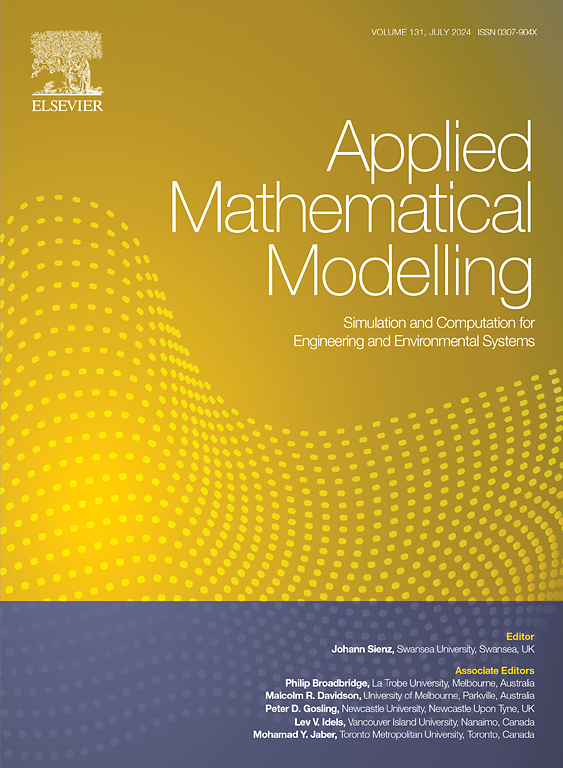Numerical modelling of internal gravity waves generated by a thermal forcing in an anelastic atmospheric flow with vertical shear
IF 4.4
2区 工程技术
Q1 ENGINEERING, MULTIDISCIPLINARY
引用次数: 0
Abstract
A numerical model is presented for internal gravity waves generated by deep or shallow latent heating in the lower atmosphere. The configuration comprises a background fluid flow with vertical shear and vertical stratification in a two-dimensional computational domain. A thermal forcing term is included in the energy conservation equation for the fluid flow. This term is sinusoidal in the horizontal direction and localized in the vertical direction and it generates a perturbation in the form of an upward-propagating internal gravity wave with a horizontal wavelength corresponding to that of the thermal forcing oscillation. If there is no critical level where the background flow speed is equal to the wave phase speed, then the wave propagates to the upper boundary of the domain where a non-reflecting boundary condition or radiation condition is imposed numerically. With a vertically-sheared background flow, where a critical level is present, nonlinear wave-mean-flow interactions occur. Vertical fluxes of momentum and energy lead to the development of higher horizontal wavenumber and zero wavenumber components. There is a transfer of momentum and energy to the background flow which reduces the wave amplitude in the upper levels of the domain and results in changes in the background velocity and temperature and the development of regions of convective instability near the critical level.
具有垂直切变的非弹性大气流动中热强迫产生的内部重力波的数值模拟
提出了低层大气深层或浅层潜热产生的内部重力波的数值模型。该结构包括在二维计算域中具有垂直剪切和垂直分层的背景流体流动。在流体流动的能量守恒方程中加入了热强迫项。这一项在水平方向上是正弦的,在垂直方向上是局部化的,它以向上传播的内部重力波的形式产生扰动,其水平波长与热强迫振荡的波长相对应。如果不存在背景流速度等于波相速度的临界水平,则波传播到数值施加非反射边界条件或辐射条件的域的上边界。在垂直剪切的背景流中,当存在临界水平时,会发生非线性波-平均流相互作用。动量和能量的垂直通量导致更高的水平波数和零波数分量的发展。动量和能量向背景流转移,降低了区域上层的波幅,导致背景速度和温度的变化以及临界附近对流不稳定区域的发展。
本文章由计算机程序翻译,如有差异,请以英文原文为准。
求助全文
约1分钟内获得全文
求助全文
来源期刊

Applied Mathematical Modelling
数学-工程:综合
CiteScore
9.80
自引率
8.00%
发文量
508
审稿时长
43 days
期刊介绍:
Applied Mathematical Modelling focuses on research related to the mathematical modelling of engineering and environmental processes, manufacturing, and industrial systems. A significant emerging area of research activity involves multiphysics processes, and contributions in this area are particularly encouraged.
This influential publication covers a wide spectrum of subjects including heat transfer, fluid mechanics, CFD, and transport phenomena; solid mechanics and mechanics of metals; electromagnets and MHD; reliability modelling and system optimization; finite volume, finite element, and boundary element procedures; modelling of inventory, industrial, manufacturing and logistics systems for viable decision making; civil engineering systems and structures; mineral and energy resources; relevant software engineering issues associated with CAD and CAE; and materials and metallurgical engineering.
Applied Mathematical Modelling is primarily interested in papers developing increased insights into real-world problems through novel mathematical modelling, novel applications or a combination of these. Papers employing existing numerical techniques must demonstrate sufficient novelty in the solution of practical problems. Papers on fuzzy logic in decision-making or purely financial mathematics are normally not considered. Research on fractional differential equations, bifurcation, and numerical methods needs to include practical examples. Population dynamics must solve realistic scenarios. Papers in the area of logistics and business modelling should demonstrate meaningful managerial insight. Submissions with no real-world application will not be considered.
 求助内容:
求助内容: 应助结果提醒方式:
应助结果提醒方式:


